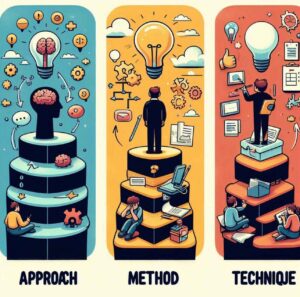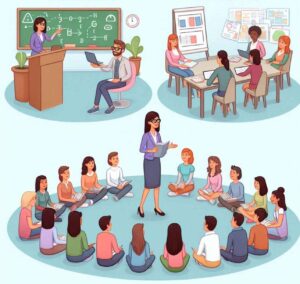
What You Need to Know to Master the Art of Language Instruction?
Introduction
How important methodology in teaching English is? If you teach English as a second or foreign language, teaching English is about more than just teaching grammar, vocabulary, and pronunciation. It is also about teaching communication, culture, and critical thinking. Importantly, it is about helping your students develop their language skills and confidence. As well as that, it is about making your lessons engaging, effective, and enjoyable.
But how do you teach English in such a way? How do you plan your lessons, choose materials, and deliver instruction? Also, how do you assess your students, provide feedback, and monitor their progress? What about dealing with the challenges and opportunities in different contexts and settings?

The answer to these questions lies in the methodology of teaching English. Methodology is the study of the principles and practices of teaching and learning. It is the science and the art of language instruction. Moreover, it is the foundation and the framework of your education.
In this article, I will introduce you to the basic concepts and principles of methodology in teaching English. I will also provide resources and references for further learning and development. The main topics that we will cover are:
- Difference between approach, method, and technique;
- Role of the teacher and the learner;
- Importance of context and needs analysis;
- The evaluation and feedback of teaching and learning.
Let’s get the ball rolling!
Difference between approach, method, and technique
One of the first things you need to know about methodology in teaching English is the difference between approach, method, and technique. These three terms are often used interchangeably but have different meanings and implications.
An approach is a set of beliefs and assumptions about the nature of language, learning, and teaching. It is the philosophy and the vision that guides your teaching.

For example:
- Structural approach– focuses on the form and structure of the language, such as grammar, vocabulary, and pronunciation.
- Functional approach– emphasizes the function and use of the language, such as communication, interaction, and expression.
- Communicative approach– combines the language’s structural and functional aspects, and emphasizes developing the four skills: listening, speaking, reading, and writing.
A method is a systematic and coherent way of implementing an approach. It is the plan and the procedure that organizes your teaching. It includes the objectives, the content, the materials, the activities, and the assessment of your lessons.
For example:
- Direct method– uses only the target language in the classroom and exposes the students to natural and authentic language input and output.
- Audio-lingual method– utilizes drills and repetition to train the students to produce correct and fluent language output.
- Suggestopedia method– employs music, relaxation, and positive suggestions to create a comfortable and conducive learning environment.
A technique is a specific and practical way of applying a method. It is the action and the activity that you use in your teaching. It includes the tasks, games, exercises, and strategies you use to teach and practice the language.

For example:
- Role-play technique– involves the students acting out different scenarios and situations using the language.
- Dictation technique– requires the teacher to read aloud a text and the students to write it down.
- Cloze technique– entails the teacher deleting some words from a text and the students filling in the blanks.
As you can see, the approach, the method, and the technique are related but different. There are various levels of abstraction and specificity. In addition, they are not fixed or rigid but flexible and adaptable. You can mix and match different approaches, methods, and techniques to suit your teaching style, students’ needs, and teaching context.
The role of the teacher and the learner
Another important thing that you need to know about methodology in teaching English is the role of the teacher and the learner. Particularly, it is the relationship and the interaction that you have with your students and that they have with you and each other.
For example:
- A teacher is a controller, and the learner is a follower. In this role, the teacher is the authority and the expert who controls the lesson’s pace, content, and outcome. The learner is the passive and obedient recipient who follows the teacher’s instructions and directions.
- The teacher is a facilitator and the learner is a participant. Here, the teacher is the guide and helper, facilitating the learning process and providing support and feedback. The learner is the active and involved participant who engages in the learning activities and interacts with the teacher and peers.
- The teacher is a co-learner and the learner is a co-teacher. In this case, the teacher is the partner and the learner, who shares the learning experience and learns from the students. The learner is the partner and the teacher, who contributes to the learning experience and teaches the teacher and the peers.
As you can see, the role of the teacher and the learner can range from hierarchical and teacher-centered to egalitarian and learner-centered, or somewhere in between. There is no right or wrong role, but different roles for different situations and purposes. The key is to be aware of the position you and your students play and adjust it according to your teaching and learning needs and goals.
The importance of context and needs analysis.
Another essential thing to know about methodology in teaching English is the importance of context and needs analysis. Context and needs analysis is gathering and analyzing information about the situation and your teaching and learning expectations. It is the research and the diagnosis that informs and guides your teaching.

Various aspects:
- Learners– their age, level, background, motivation, interests, preferences, strengths, weaknesses, goals, and challenges.
- Teacher– qualifications, experience, style, personality, beliefs, values, and attitudes.
- Curriculum– the syllabus, the materials, the resources, the standards, and the outcomes of your teaching and learning.
- Environment– the setting, location, facilities, equipment, culture, and atmosphere of your teaching and learning.
Steps:
- First, understand your students and yourself better and build rapport and trust with them.
- Next, plan your lessons, choose your methods and techniques more effectively and efficiently, and tailor them to your students’ needs and goals.
- Then, deliver your instruction, assess your students more accurately and appropriately, and provide relevant and constructive feedback and support.
- Lastly, evaluate and improve your teaching and learning more objectively and systematically, and identify and address the problems and the opportunities.
Context and needs analysis is not a one-time or a static process but a continuous and dynamic process. Besides, it is not something you do before or after your teaching but something you do throughout your education. Also, it is not something that you do alone or in isolation, but something that you do with your students and your colleagues. Most importantly, it is not something you do for the sake of doing but for growing.
The evaluation and feedback of teaching and learning
The last but not the most minor thing you need to know about methodology in teaching English is the evaluation and feedback of teaching and learning. Undoubtedly, assessment and feedback measure and judge the quality and effectiveness of your education and learning.
Various aspects:
- Input– objectives, content, materials, activities, and resources
- Process– methods, techniques, strategies, and interactions
- Output– outcomes, results, achievements, and impacts of your teaching and learning.

Importance:
- First, it monitors and tracks your teaching and learning progress and performance and compares them with your expectations and standards.
- Second, it identifies and celebrates your teaching and learning strengths and successes, and acknowledges and rewards your efforts and achievements.
- Third, it recognizes and addresses your teaching and learning weaknesses and failures, and learns from your mistakes and challenges.
- Fourth, it enhances and optimizes your teaching and learning quality and effectiveness to make your teaching and learning more engaging, meaningful, and enjoyable.
Evaluation and feedback are not one-way or top-down processes but two-way or bottom-up approaches. It is not something you give or receive but share and exchange. In addition, it is not something you do to or for your students but something you do with and by them. Finally, it is not something that you do to criticize or to praise but something that you do to communicate and collaborate.
Conclusion
In this article, I have introduced you to the basic concepts and principles of methodology in teaching English. As we close this article, let us remember this quote by Confucius: “I hear and I forget. I see, and I remember. I do, and I understand.” This quote reminds us that the best way to learn and teach English is by doing and practicing, not just listening and reading. By applying the concepts and principles of methodology in teaching English to our classroom, we can make our teaching and learning more interactive, experiential, and meaningful. Happy teaching!
If you have any questions or comments on the Methodology in Teaching English, feel free to leave them below. Thanks for reading, and I’ll see you at the next one!



